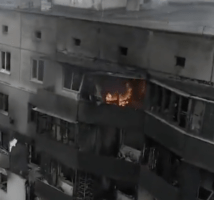The videos from Chernihiv this evening seem an extreme escalation even by the standards of this hideous Russian campaign – suggest the Aleppo option for Ukrainian cities is very much on the table: pic.twitter.com/39RIdCHwYE
— Shaun Walker (@shaunwalker7) March 3, 2022
Some Background
As 2021 came to a close, Russia presented the United States with a list of demands it said were necessary to stave off the possibility of a large-scale military conflict in Ukraine. In a draft treaty delivered to a U.S. diplomat in Moscow, the Russian government asked for a formal halt to NATO’s eastern enlargement, a permanent freeze on further expansion of the alliance’s military infrastructure (such as bases and weapons systems) in the former Soviet territory, an end to Western military assistance to Ukraine, and a ban on intermediate-range missiles in Europe. The message was unmistakable.
For years, Putin has been saying Russians and Ukrainians are so closely historically and culturally aligned that they are essentially one people.
He has also said that Ukraine as an independent country is an artificial construct and lamented the breakup of the Soviet Union as “the greatest geopolitical catastrophe of the century.”
As he moved toward war, his skewed views on Ukraine’s history and statehood re-emerged, leaving even the most seasoned of Kremlinologists alarmed.
In a rambling speech, the Russian leader said modern Ukraine was “entirely created by communist Russia” and had since fallen into the hands of nationalists and corrupt “puppets” controlled by the West. He said it was not “just a neighboring country,” but an “an integral part of our own history, culture and spiritual space.
Ratcheting up tensions, Moscow launched massive military drillswith close ally Belarus, to Ukraine’s north, amassing an estimated 30,000 troops and heavy military equipment — the biggest such deployment to the former Soviet state since the Cold War, according to NATO.
The industrial region of Donbas, internationally recognized as Ukrainian but partly controlled by the separatists, quickly became the flashpoint in a broader standoff that the U.S. and its allies had feared.
But the leaders of the two breakaway regions in eastern Ukraine, the self-proclaimed “Donetsk People’s Republic” and “Luhansk People’s Republic,” ordered their residents to evacuate to Russia, warning of an imminent attack by the Ukrainian army — which Kyiv adamantly denied. Russian state media began to deliver a flood of public reports about alleged “atrocities” taking place in the region, which Putin has repeatedly called a “genocide.” International monitors categorically deny that’s the case.
Just days later, Putin conducted apparently staged consultations with senior Kremlin officials.
One by one, they lined up to tell him that the only way to stop the alleged “carnage” in Donbas was to recognize the separatist regions as independent. Hours later Putin did just that, while also promising to send Russian troops into the breakaway republics under the guise of “peacekeepers.”
The move was met with international condemnation and sanctions, and the U.S. called it the beginning of a Russian invasion of Ukraine.
After much speculation, Putin clarified that he had recognized the breakaway regions’ claim to the borders that existed when they proclaimed their independence in 2014 and that included vast swaths of territory held by Ukraine.
The Russian leader was also given carte blanche to move his troops outside Russia after the country’s parliament rubber-stamped his request.
With Putin’s plan taking shape, Ukraine’s leaders moved to introduce a state of emergency and began conscripting reservists.
After hours of frenzied rumors and reports of Russian troop movements, Putin delivered his address and launched his attack.
This is how it’s going.
Russia’s liberation pic.twitter.com/7rlsAKXmr6
— Luke Coffey (@LukeDCoffey) March 3, 2022
If you want a great background in the run-up to the invasion – go here. https://www.nbcnews.com/news/world/why-putin-invaded-ukraine-russia-war-explained-rcna16028

